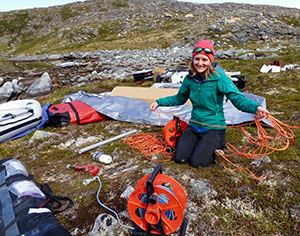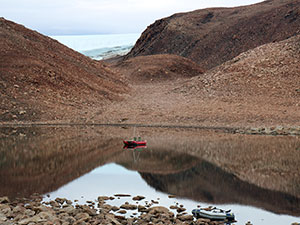UW Researcher Heads Study of Methane Cycling Changes in Arctic Lakes
Published September 29, 2023

Predicting methane cycling changes in Arctic lakes is of global concern in a warming world. However, records constraining lake methane dynamics with past warming are rare.
A University of Wyoming researcher has shed some new light on the subject by demonstrating the hydrogen isotopic composition of midchain waxes -- molecular fossils derived from aquatic plants -- reveals that past warming during the middle Holocene period led to expanded methane cycling in lakes across Greenland. The early to middle Holocene period, which followed the ice age, is 11,700 to 4,200 years ago.
“This work is interesting because it shows that sustained climate warming in the past -- i.e., the early-middle Holocene -- led to an increase in methane cycling in Arctic lakes,” says Jamie McFarlin, an assistant professor in UW’s Department of Geology and Geophysics. “We observe in these geologic records that it takes some time for the conditions to develop for lake methane cycling to increase. But, once it develops, the lakes in our study maintain an intensified methane cycle for thousands of years until the onset of late Holocene cooling. This supports a climate dependence on lake methane cycling in some Arctic lakes.”
McFarlin was lead author of a paper titled “Aquatic plant wax hydrogen and carbon isotopes in Greenland lakes record shifts in methane cycling during past Holocene warming” that was published today (Friday) in Science Advances. Science Advances is the American Association for the Advancement of Science’s open-access, multidisciplinary journal that publishes impactful research papers and reviews in any area of science, in both disciplinary-specific and broad interdisciplinary areas.
Lakes are a significant natural source of the potent greenhouse gas methane. Arctic and boreal landscapes are warming faster than any region on Earth and have the highest density of lakes in the world, according to the study.
The research group documented methane cycling in a geologic archive -- lake sediment cores -- from a new perspective: the hydrogen isotopic composition of aquatic plant waxes. This approach presented an expansion to the framework of an important geologic tool -- plant waxes as a paleoenvironmental proxy.
This work draws attention to the unquantified role of common aquatic brown mosses as a potentially important sink of lake methane across the Arctic, according to the study.
“Prior to this work, the hydrogen isotopic composition of these compounds was mostly interpreted as representative of precipitation,” McFarlin explains. “This presents a new opportunity to further explore and understand dynamics in past lake methane cycling that develop over geologic time scales.”
The group hypothesizes that lake dynamics similar to the early-middle Holocene could develop with ongoing modern warming in many lakes across the Arctic, potentially leading to an increase in lake methane emissions that aren’t fully accounted for at present.

The study uses data that McFarlin and her fellow co-authors produced between 2014-2021 and, importantly, also reinterprets data from the published literature. The fieldwork component in which McFarlin participated largely took place during summer 2014 in northwest Greenland. The study focused on four lakes: Wax Lips Lake, Trifna Sø, Lake N3 and Pluto Lake.
The research began when McFarlin was working toward her Ph.D. at Northwestern University; continued during her postdoctoral work at the University of Colorado-Boulder; and was completed after she came to UW as an assistant professor.
The study was conducted with Northwestern University colleagues Yarrow Axford, the William Deering Professor of Geological Sciences; Andrew Masterson, a senior research associate at the time of the study but now a research scientist with the U.S. Geological Survey; Everett Lasher, a Ph.D. student at Northwestern during the study but now a physical scientist with the U.S. Geological Survey; and Magdalena Osburn, an associate professor and curriculum chair in Northwestern’s Department of Earth and Planetary Sciences. Stephanie Kusch, a professor of chemical oceanography at the University of Quebec-Rimouski in Rimouski, Quebec, Canada, also was involved in the study.
“The Arctic has huge areas covered in lakes. Not every lake has mosses that will record methane dynamics, but our study also highlights that those vast swaths of Arctic lakes are vulnerable to climate-driven changes in methane cycling, whether mosses are on-site to witness those changes or not,” Axford says. “This is yet another way that rapid warming in the Arctic could affect global climate.”
“These data show increased periods of methane cycling during past warm periods,” Osburn adds. “Living on a warming planet, we can look to these signs from the past to help predict our future. We suspect this process is going to become more and more important in the future of these lakes.”
The study was supported by the National Science Foundation (NSF) Office of Polar Programs; an NSF Graduate Research Fellowship; the Paula M. Trienens Institute for Sustainability and Energy at Northwestern University; and a Geological Society of America Graduate Research Award.

